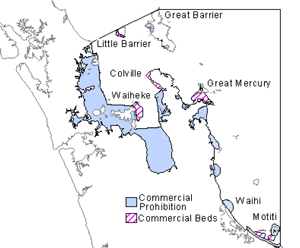- Fisheries Management in New Zealand
- Species
- Customary
- Aotea Great Barrier Temporary Closure 2023
- Astrolabe Reef s186A closure 2016
- Coromandel East temporary closure 2021
- Coromandel East temporary closure 2024
- Hauraki Gulf temporary closures 2024
- Kauaetangohia Mātaitai
- Maunganui Bay temporary closure
- Napier Reef temporary closure 2025
- Napier Reef temporary closure 2023
- Ōhiwa Harbour temporary closure 2024
- Ōmāui Mātaitai 2019-20
- Ruapuke Island Mātaitai 2024
- Taranaki temporary closure 2024
- Taranaki temporary closure 2022
- Tautuku Mātaitai 2019-21
- Te Māta temporary closure
- Tutukaka – Ngunguru temporary closure 2023
- Umupuia temporary closure
- Waiheke temporary closure 2021-24
- Waimārama temporary closure 2024
- Waimārama temporary closure 2020 -22
- Whale Island mātaitai 2024
- Whangaroa temporary closure 2021
- Fisheries policy & reform
- Fisheries plans
- Legislation and reviews
- Regulatory reviews
- Aggregation limits application 2024
- Aggregation excess limits EMA KAH 2020
- Crayfish Aggregation limit exemption 2016
- Deemed value review 2016
- Deemed value review 2021
- Deemed value review 2022
- Finfish bag limits review 2021
- Fiordland amateur regulations review 2022
- Papamoa Beach bylaw review 2018
- Seabird mitigation measures 2023
- Technical change proposals 2022
- Submissions by year
- North & South Islands submissions
- 2025 Submissions
- 2024 Submissions
- Aggregation limits application 2024
- Blue cod Marlborough Sounds review 2024
- Coromandel East temporary closure 2024
- Crayfish 1 management review 2024
- Crayfish 3 TAC review 2024
- Crayfish 7 and 8 review 2024
- Exception review for predated HMS 2024
- Extend coastal permits bill 2024
- Fast Track Approvals Bill 2024
- Hauraki Gulf temporary closures 2024
- Jack mackerel pilchard kingfish review 2024
- Kaikōura Pāua 3A TAC review 2024
- Kaikōura pāua reopening 2024
- Kina 1 review 2024
- Kina 3 TAC review 2024
- Kingfish 3 TAC review 2024
- Ōhiwa Harbour temporary closure 2024
- Pacific bluefin landing review 2024
- Ruapuke Island Mātaitai 2024
- Snapper flatfish elephantfish 7 review 2024
- Snapper Rig John dory 2 review 2024
- Snapper 8 TAC review 2024
- Southern bluefin landing review 2024
- Southern bluefin TAC review 2024
- Taranaki temporary closure 2024
- Waikato Regional Coastal Plan 2022-25
- Waimārama temporary closure 2024
- Whale Island mātaitai 2024
- 2023 submissions
- Aotea Great Barrier Temporary Closure 2023
- Coromandel scallop closure review 2023
- Crayfish 1 TAC review 2023
- Deemed values review SNA 2023
- Gurnard 3 TAC review 2023
- Industry Transformation Plan 2023
- Hauraki Gulf Fisheries Plan 2023
- Hauraki Gulf trawl corridors 2023-25
- Kina 1 TAC review 2023
- Kina dredging Tory Channel review 2023
- Marine Protection Bill 2023–25
- Napier Reef temporary closure 2023
- Pāua 2 Fisheries Plan 2023-24
- Pāua 2 TAC review 2023
- Red cod land-all catch review 2023
- Seabed mining inquiry 2023
- Seabird mitigation measures 2023
- Trevally 2 TAC review 2023
- Tutukaka – Ngunguru temporary closure 2023
- Waikato Regional Coastal Plan 2022-25
- 2022 submissions
- Blue cod 7 TAC review 2022
- Crayfish 1, 7 & 8 TAC review 2022
- Deemed value review 2022
- Fiordland amateur regulations review 2022
- Fisheries Amendment Bill 2022
- FMA 7 TAC review 2022
- Gurnard 3 TAC review 2022
- Habitats of significance 2022
- Hākaimangō-Matiatia (Northwest Waiheke) Marine Reserve
- Hāpuku Bass 7 & 8 TAC Review 2022/23
- Hauraki Gulf Marine Protected Areas 2022
- Kaikōura pāua reopening 2022
- Maunganui Bay temporary closure
- Northland area closure proposals 2022
- Pāua 5 Draft Fisheries Plan
- Rig 3 TAC review 2022
- Northland & Coromandel Scallop TAC Review 2022
- Tarakihi east coast TAC review 2022
- Taranaki temporary closure 2022
- Technical change proposals 2022
- Te Māta closure application
- Waikato Region Coastal Plan 2022
- Waimārama temporary closure 2020 -22
- Umupuia temporary closure 2008-2024
- 2021 submissions
- Blue cod 3 TAC review 2021
- Cameras on boats 2021
- Clive River dredging 2021
- Coromandel East temporary closure 2021
- Crayfish 1, 3, 4, 5 & Packhorse TAC review 2021
- Elephant fish 7 TAC review 2021
- Finfish bag limits review 2021
- Flatfish 2 TAC review 2021
- Gurnard 1 TAC review 2021
- Hāpuku-Bass 1 & 2 TAC review 2021
- Kaikōura pāua fishery reopening 2021
- Kingfish 8 Deemed value review 2021
- Snapper 8 TAC review 2021
- Southern bluefin tuna TAC review 2021
- Tarakihi east coast TAC review 2021
- Waiheke temporary closure 2021-24
- Whangaroa temporary closure 2021
- Yellow-eyed mullet 9 TAC review 2021
- 2020 submissions
- Aggregation limits kahawai, jack mackerel 2020
- Blue cod 5 TAC review 2020
- Crayfish 1, 3, 4, 7 & 8 TAC review 2020
- Crayfish ACE carry forward 2020
- Gurnard 7 TAC review 2020
- Kingfish 2, 3, 7 & 8 TAC review. July 2020
- Maunganui Bay temporary closure
- National Finfish Fisheries Plan 2019-20
- National Rock Lobster Management Group review 2020
- Northland scallop TAC review 2020
- Pāua 3 subdivision 2020
- Pōrae 1 TAC review 2020
- Sea Change Marine Spatial Plan 2014-21
- Snapper 7 TAC review 2020
- South Island trawl species review 2020
- Tautuku Mātaitai application 2019-21
- Waimārama temporary closure 2020 -22
- 2019 submissions
- 2018 Submissions
- 2017 Submissions
- 2016 Submissions
- Astrolabe Reef closure application
- Bluenose management review
- Coromandel Scallops
- Crayfish 3 Gisborne
- Crayfish management 2016
- Deemed values 2016
- Jack mackerel 3 management review
- John dory 7 management review
- Paua 7 South Island
- Quota aggregation limits exemption
- Scallops (SCA7) management 2
- Seabed mining Taranaki 2016
- Snapper 7 management review
- Surf Clam 7 review 2016
- 2015 Submissions
- 2014 Submissions
- 2013 Submissions
- 2012 Submissions
- 2011 Submissions
- 2010 Submissions
- 2009 Submissions
- 2008 Submissions
- 2007 Submissions
- Regional issues
- Aquaculture
- Bay of Plenty
- Hauraki Gulf
- Coromandel East temporary closure 2021
- Hākaimangō-Matiatia (Northwest Waiheke) Marine Reserve 2022
- Hauraki Gulf Fisheries Plan 2023
- Hauraki Gulf Marine Protected Areas 2022
- Hauraki Gulf trawl corridors 2023-25
- Marine Protection Bill 2023–25
- Ponui mussel farm proposal
- Sea Change Marine Spatial Plan 2014-21
- Te Māta temporary closure
- Umupuia temporary closure 2008-2024
- Coromandel scallop closure review 2023
- Waiheke temporary closure 2021-24
- Waikato Region Coastal Plan 2022
- Waikato Regional Coastal Plan 2022-25
- Marlborough and Tasman
- Northland
- Southland and Otago
- Marine protection
- RMA
- Research and reports
- Document Index
- Document Search
Coromandel Scallops
Management review 2016

Introduction
The Coromandel scallop fishery is the second largest in the country, behind the Marlborough-Tasman fishery.
Management of commercial scallop fishing has been controversial over the years resulting in some areas of high public interest in the Hauraki Gulf being closed to commercial harvesting.
Recreational fishers object to the continued use of the Victorian box dredge by commercial scallop fishers, due to the damaging effects on benthic life and the continued destruction of once-healthy scallop beds.
Commercial catch levels in the Coromandel fishery was historically based on annual abundance surveys of known scallop beds. The last biomass survey was conducted in 2012.
In the 2013 the Minister for Primary Industries increased the the Total Allowable Commercial Catch (TACC) from 22 to 100 tonnes and it remains at this level. Commercial landings over the past 8 years have averaged 47 tonnes. Commercial landings in 2014/15 was 34 tonnes.
In 2016 the Ministry for Primary Industries (MPI) proposed two options for the future management of Coromandel scallops: the status quo or a 50% reduction in the TACC.
The New Zealand Sport Fishing Council (NZSFC) advocates that MPI works with all stakeholders to develop an agreed management plan incorporating in-season catch and effort controls, and an annual public report outlining harvest strategies and commercial operations. This would make management more transparent and give the public some confidence that this fish stock is being managed in the long-term interests of the fishery and future generations.
Click on the right-hand image to download the document. Most recent activity is at the top of the list.
Minister’s decision. Coromandel scallops. 17 March 2016
Nathan Guy, the Minister for Primary Industries, has agreed to reduce the Total Allowable Catch (TAC) in the Coromandel scallop fishery from 131 to 81 tonnes, meatweight. He has also decided to cut the Total Allowable Commercial Catch (TACC) in half, from 100 to 50 tonnes, meatweight. A TAC and TACC cut was the only course of action given the depleted state of this fishery.
NZSFC Submission. 11 February 2016
The New Zealand Sport Fishing Council recommends the Minister exercises his statutory powers and obligations to prohibit the use of Victorian box dredges in the Coromandel scallop fishery due to their damaging effects on scallops, benthic communities and habitats that sustain other species.
The New Zealand Sport Fishing Council review of the Ministry’s proposal and their views on the future management of the Coromandel scallop fishery. This document also outlines the Council’s initial concerns about the proposals and the ongoing mismanagement of this important fishery for the people of the Hauraki Gulf and western Bay of Plenty.
MPI proposal document. 14 January 2016
The Ministry for Primary Industries (MPI) propose two options for the future management of the Coromandel scallop fishery: 1. the status quo, or 2. cut the Total Allowable Commercial Catch (TACC) by 50%. This document outlines the Ministry’s proposal, the rationale for their proposal and initial views from commercial stakeholders.
MPI plenary. November 2012
This plenary document outlines the historic management of the Coromandel scallop fishery. It provides past commercial catch landings and catch limits. The document also explains the biology and other stock related factors relevant to the management of this important fishery. The plenary is an approved Ministry document reviewed by Ministry and external scientists and stakeholders. Plenaries are reviewed on a regular basis, depending on the availability of new information.
Details of NZSFC input to reviews by year – |
2016 |
2013 |
2011-12 |
2010 |
2007 |